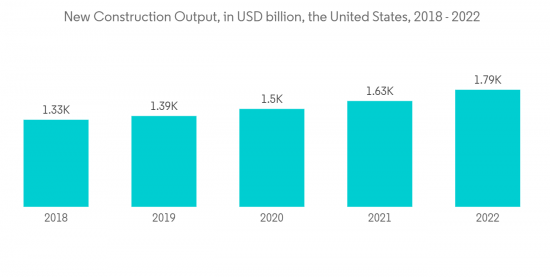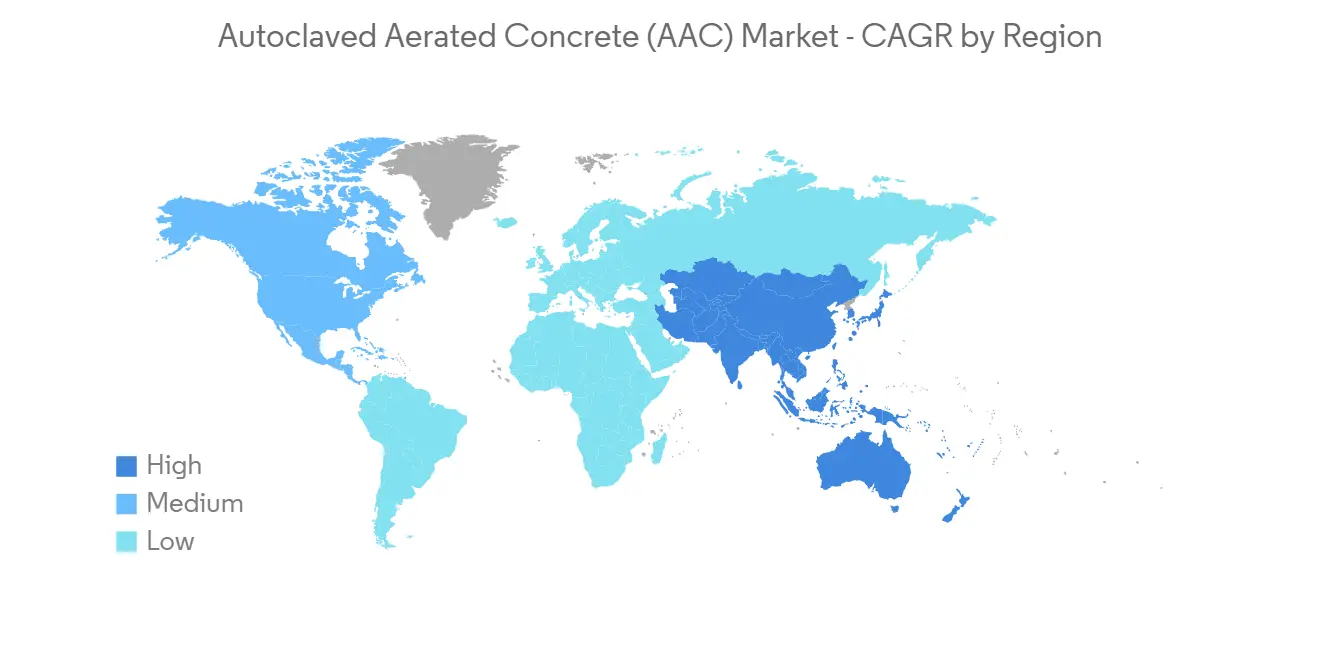 |
市场调查报告书
商品编码
1326391
蒸压加气混凝土 (AAC) 市场规模和份额分析 - 增长趋势和预测 (2023-2028)Autoclaved Aerated Concrete (AAC) Market Size & Share Analysis - Growth Trends & Forecasts (2023 - 2028) |
||||||
※ 本网页内容可能与最新版本有所差异。详细情况请与我们联繫。
蒸压加气混凝土 (AAC) 市场规模预计将从 2023 年的 52.6 亿美元增长到 2028 年的 70.5 亿美元,预测期内(2023-2028 年)复合年增长率为 6.05%。
COVID-19 大流行对市场产生了负面影响。世界各地的建筑工程已陷入停顿,尤其是在中国和印度等重要建筑中心。但2021年,行业復苏,市场需求恢復。
主要亮点
- 短期内,市场增长是由全球建设和重建项目数量不断增加推动的。
- 另一方面,加气混凝土砌块的製造成本高于普通水泥或粘土砌块,预计这将阻碍市场增长。
- 然而,对阻燃建筑材料使用的重视预计将成为未来市场增长的机会。
- 亚太地区预计将主导市场,其中中国、印度和日本的消费量最大。
蒸压加气混凝土(AAC)市场趋势
建筑行业需求不断增长
- AAC 用于建筑,因为它具有防火、防白蚁、防虫害、抗震、轻质、可持续、快速且易于安装、以及隔热和节能等特点。
- 由于该国投资和建设活动的增加,预计在预测期内对自细胞混凝土的需求将增加。近年来,中国一直是世界基础设施建设的主要投资者之一,做出了重要贡献。例如,根据国家统计局(NBS)的数据,2022年中国建筑业产值达到27.63万亿元人民币(4.11万亿美元),比2021年增长6.6%。因此,国内建筑业的不断增长预计将为自加气混凝土市场创造向上的需求。
- 美国拥有世界上最大的建筑业之一。据美国人口普查局统计,2022年美国新建建筑产值达1.79万亿美元,较2021年增长10.40%至1.63万亿美元。另外,2022年该国商业建筑总额为1147.9亿美元,而2021年为910.3亿美元,较2021年增长21.5%。因此,美国商业建筑产量的增加预计将增加自加气混凝土市场的需求。
- 此外,沙特阿拉伯正在开展许多商业项目,并且可能会建造更多的商业建筑。Qiddiya Entertainment 是价值5000 亿美元的未来巨型城市Neom 项目的一部分,计划于2025 年竣工,包括分布在五个岛屿和两个内陆度假村的14 家豪华和超豪华酒店,拥有3,000 间客房;Qiddiya Entertainment City 是超豪华健康中心目的地阿玛阿拉 (Amaala) 和让努维尔 (Jean Nouvel) 位于欧拉 (Al-Ula) 的 Sharaan 度假村。
- 英国政府已宣布建设新学校是当务之急。英国的学校改造项目预计将对加气混凝土市场产生积极影响。例如,英国政府宣布,作为具有里程碑意义的十年计划的一部分,将对英国 239 所学校进行翻修。
- 除了学校重建计划外,政府每年还向学校土地投入资本金。自 2015 年以来,已拨款超过 130 亿英镑(160.7 亿美元)用于维护和改善英格兰各地的学校设施,2022-23 财年将拨款 18 亿英镑(22.26 亿美元)。
- 继秋季声明中宣布为学校明年和后年增加 20 亿英镑(24.73 亿美元)额外资金后,政府还将决定明年向地方当局分配学校资金。到 2024-25 年,每个学生的实际学校经费预计将达到历史新高,总计达到 588 亿英镑(727.29 亿美元)。因此,建筑行业的此类投资预计将导致加气混凝土的需求增加。
- 由于上述因素,预计在预测期内对自泡沫混凝土的需求将激增。

亚太地区主导市场
- 由于中国和印度等国家建筑行业的高需求,亚太地区在 ACC 市场上占据主导地位。
- 预计印度仍将是亚太地区二十国集团中增长最快的经济体。印度政府宣布三年(2023-2025年)基础设施投资目标为3765亿美元,其中1205亿美元用于发展27个产业集群,7530亿美元用于公路、铁路和港口互联互通项目。 。
- 印度房地产行业正在崛起,政府的支持和举措进一步提振了需求。据印度品牌股权基金会(IBEF)称,住房和城市发展部(MoHUA)已在2022-2023年预算中拨款98.5亿美元,为住房建设和完成停滞项目创造资金。
- 此外,2022年12月,印度机场管理局(AAI)等机场开发商宣布,机场部门将在未来五年内投入约10万元人民币,用于扩建或翻新现有航站楼、建设新航站楼、加固跑道等。其资本支出目标为 98,000 卢比(118 亿美元)。因此,这些扩建工程预计将增加对自泡沫混凝土材料的需求。
- 据国土交通省称,雨季结束后日本的建筑开工量将会增加。2022 年,日本将开工约 859,500 套住房。与 2021 年相比,增长了 0.4%。因此,日本新屋开工数量的增加预计将导致对自泡沫混凝土的需求增加。
- 因此,所有这些有利的发展和当地投资预计将在预测期内推动对汽车细胞混凝土的需求。

蒸压加气混凝土 (AAC) 行业概述
自动填充加气混凝土 (AAC) 市场本质上高度分散。该市场的主要参与者(排名不分先后)包括 Xella International、H+H、ACICO Group、SOLBET 和 Tarmac。
其他福利:
- Excel 格式的市场预测 (ME) 表
- 3 个月的分析师支持
目录
第 1 章 简介
- 调查先决条件
- 调查范围
第二章研究方法论
第三章执行摘要
第四章市场动态
- 促进者
- 建筑行业需求不断增长
- 越来越重视绿色建筑(LEED 评级)
- 其他促进者
- 抑製剂
- 初始成本高
- 限制在承重墙中的使用
- 行业价值链分析
- 波特五力分析
- 供应商的议价能力
- 买方议价能力
- 新进入者的威胁
- 替代品的威胁
- 竞争程度
第五章 市场细分(基于金额的市场规模)
- 类型
- 堵塞
- 楣
- 控制板
- 瓦
- 其他类型
- 用法
- 家用
- 工业的
- 商业的
- 其他用途
- 区域
- 亚太地区
- 中国
- 印度
- 日本
- 韩国
- 澳大利亚/新西兰
- 东盟国家
- 亚太其他地区
- 北美
- 美国
- 加拿大
- 墨西哥
- 欧洲
- 德国
- 法国
- 英国
- 北欧国家
- 波兰
- 捷克共和国
- 罗马尼亚
- 比利时
- 荷兰
- 欧洲其他地区
- 南美洲
- 巴西
- 阿根廷
- 哥伦比亚
- 其他南美洲
- 中东/非洲
- 沙特阿拉伯
- 南非
- 卡塔尔
- 以色列
- 南非
- 其他中东和非洲
- 亚太地区
第六章 竞争格局
- 併购、合资、联盟、协议
- 市场份额(%)**/排名分析
- 各大公司的战略
- 公司简介
- ACICO Group
- AERCON AAC
- AKG Gazbeton
- BAUROC AS
- Biltech Building Elements Limited
- Eastland Building Materials Co., Ltd
- Eco Green
- H+H
- HIL Limited
- JK Lakshmi Cement Ltd
- Renaatus Procon Private Limited
- SOLBET
- Tarmac
- Xella International
- Thomas Armstrong(Concrete Blocks)Limited
- UltraTech Cement Ltd.
第七章市场机会与未来趋势
- 重点转向使用绿色化学品
- 其他机会
The Autoclaved Aerated Concrete (AAC) Market size is expected to grow from USD 5.26 billion in 2023 to USD 7.05 billion by 2028, at a CAGR of 6.05% during the forecast period (2023-2028).
The COVID-19 pandemic negatively impacted the market. Construction work stopped worldwide, especially in significant construction hubs like China and India. However, the industry witnessed a recovery in 2021, thus rebounding the demand for the market studied.
Key Highlights
- Over the short term, the increasing construction and redevelopment projects across the world are some of the factors driving the growth of the market studied.
- On the flip side, the cost of manufacturing an AAC block is higher than normal cement or burnt clay blocks, which is expected to hinder the growth of the market studied.
- However, the emphasis on using fire-retardant building materials is expected to provide opportunities for the growth of the market in the future.
- The Asia-Pacific region is expected to dominate the market, with the largest consumption coming from China, India, and Japan.
Autoclaved Aerated Concrete (AAC) Market Trends
Growing Demand from the Construction Industry
- AAC, owing to its thermally insulated and energy-efficient properties, along with being fire-resistant, termite- or pest-resistant, seismic-resistant, lightweight, sustainable, and quick and easy to apply, is used in construction.
- The demand for autoclaved aerated concrete is expected to rise throughout the forecast period due to rising investments and construction activity in the country. China is a huge contributor, as it has been one of the leading investors in infrastructure worldwide over the past few years. For instance, according to the National Bureau of Statistics (NBS) of China, in 2022, the output value of construction works in China amounted to 27.63 trillion yuan (USD 4.11 trillion), an increase of 6.6% compared with 2021. Therefore, the increasing construction industry in the country is expected to create upside demand for the autoclaved aerated concrete market.
- The United States has one of the world's largest construction industries. According to the US Census Bureau, the output value of new construction in the United States amounted to USD 1.79 trillion in 2022, which showed an increase of 10.40% compared to 2021, reaching USD 1.63 trillion. Apart from that, the total commercial construction value in the country accounted for USD 91.03 billion in 2021 compared to USD 114.79 billion in 2022, which showed an increase of 21.5% compared to 2021. Therefore, increasing commercial construction output in the United States is expected to increase demand for the autoclaved aerated concrete market.
- Moreover, Saudi Arabia works on many commercial projects, likely leading to more commercial buildings. The USD 500 billion futuristic mega-city "Neom" project, the Red Sea Project, Phase 1, which is expected to be completed by 2025 and has 14 luxury and hyper-luxury hotels with 3,000 rooms spread across five islands and two inland resorts, Qiddiya Entertainment City, Amaala, the uber-luxury wellness tourism destination, and Jean Nouvel's Sharaan resort in Al-Ula Therefore, upcoming investments from the construction industry are expected to create upside demand for the autoclaved aerated concrete market in the country.
- The government of the United Kingdom had announced initiatives to construct new schools as a top priority. School renovation projects in England are expected to create an upside for the autoclaved aerated concrete market. For instance, according to the United Kingdom government's publication, 239 school buildings are to be transformed as part of a revolutionary ten-year program in England.
- In addition to the school rebuilding program, the government invests in the school estate with annual capital funding. Over GBP 13 billion (USD 16.07 billion) has been allocated since 2015 to maintain and improve school facilities across England, including GBP 1.8 billion (USD 2.226 billion) in the financial year 2022-23.
- Moreover, the government is also setting out school funding allocations for local authorities for next year, following the extra GBP 2 billion (USD 2.473 billion) funding boost for schools for next year and the year after announced in the Autumn Statement. School funding is expected to be at its highest-ever level in real terms per pupil, totaling GBP 58.8 billion (USD 72.729 billion) by 2024-25. Therefore, these investments in the construction industry are expected to create upside demand for autoclaved aerated concrete.
- Owing to all the above factors, the demand for autoclaved aerated concrete is expected to surge during the forecast period.

Asia-Pacific to Dominate the Market
- Asia-Pacific accounts for most of the ACC market owing to the high demand from the construction sector in countries like China and India.
- India is anticipated to remain the fastest-growing G20 economy in the Asia-Pacific region. The Indian government announced a target of USD 376.5 billion in infrastructure investment over three years (2023-2025), including USD 120.5 billion for developing 27 industrial clusters and USD 75.3 billion for road, railway, and port connectivity projects.
- The residential sector in India is on an increasing trend, with government support and initiatives further boosting demand. According to the India Brand Equity Foundation (IBEF), the Ministry of Housing and Urban Development (MoHUA) allocated USD 9.85 billion in the 2022-2023 budget to construct houses and create funds to complete the halted projects.
- Moreover, in December 2022, the Airports Authority of India (AAI) and other airport developers targeted a capital outlay of approximately Rs. 98,000 crores (USD 11.8 billion) in the airport sector in the next five years for expansion and modification of existing terminals, new terminals, and strengthening of runways, among other activities. Therefore, these expansions are expected to increase the demand for autoclaved aerated concrete materials.
- According to the Ministry of Land, Infrastructure, Transport, and Tourism (MLIT), building starts will increase in Japan after the rainy season. In 2022, approximately 859.5 thousand housing starts were initiated in Japan. This represents an increase of 0.4% compared to 2021. Therefore, the increasing number of housing starts in Japan is expected to create upside demand for autoclaved aerated concrete.
- Hence, all such favorable trends and regional investments are expected to drive the demand for autoclaved aerated concrete during the forecast period.

Autoclaved Aerated Concrete (AAC) Industry Overview
The autoclaved aerated concrete (AAC) market is highly fragmented in nature. The major players in this market (not in a particular order) include Xella International, H+H, ACICO Group, SOLBET, and Tarmac.
Additional Benefits:
- The market estimate (ME) sheet in Excel format
- 3 months of analyst support
TABLE OF CONTENTS
1 INTRODUCTION
- 1.1 Study Assumptions
- 1.2 Scope of the Study
2 RESEARCH METHODOLOGY
3 EXECUTIVE SUMMARY
4 MARKET DYNAMICS
- 4.1 Drivers
- 4.1.1 Growing Demand from the Construction Industry
- 4.1.2 Increased Emphasis on Green Buildings (LEED Ratings)
- 4.1.3 Other Drivers
- 4.2 Restraints
- 4.2.1 High Initial Cost
- 4.2.2 Limited Usage in Load Bearing Walls
- 4.3 Industry Value Chain Analysis
- 4.4 Porter's Five Forces Analysis
- 4.4.1 Bargaining Power of Suppliers
- 4.4.2 Bargaining Power of Buyers
- 4.4.3 Threat of New Entrants
- 4.4.4 Threat of Substitute Products and Services
- 4.4.5 Degree of Competition
5 MARKET SEGMENTATION (Market Size in Value)
- 5.1 Type
- 5.1.1 Block
- 5.1.2 Lintel
- 5.1.3 Panel
- 5.1.4 Tile
- 5.1.5 Other Types
- 5.2 Application
- 5.2.1 Residential
- 5.2.2 Industrial
- 5.2.3 Commercial
- 5.2.4 Other Applications
- 5.3 Geography
- 5.3.1 Asia-Pacific
- 5.3.1.1 China
- 5.3.1.2 India
- 5.3.1.3 Japan
- 5.3.1.4 South Korea
- 5.3.1.5 Australia and New Zealand
- 5.3.1.6 ASEAN Countries
- 5.3.1.7 Rest of Asia-Pacific
- 5.3.2 North America
- 5.3.2.1 United States
- 5.3.2.2 Canada
- 5.3.2.3 Mexico
- 5.3.3 Europe
- 5.3.3.1 Germany
- 5.3.3.2 France
- 5.3.3.3 United Kingdom
- 5.3.3.4 NORDIC Countries
- 5.3.3.5 Poland
- 5.3.3.6 Czech Republic
- 5.3.3.7 Romania
- 5.3.3.8 Belgium
- 5.3.3.9 Netherlands
- 5.3.3.10 Rest of Europe
- 5.3.4 South America
- 5.3.4.1 Brazil
- 5.3.4.2 Argentina
- 5.3.4.3 Colombia
- 5.3.4.4 Rest of South America
- 5.3.5 Middle-East and Africa
- 5.3.5.1 Saudi Arabia
- 5.3.5.2 South Africa
- 5.3.5.3 Qatar
- 5.3.5.4 Israel
- 5.3.5.5 South Africa
- 5.3.5.6 Rest of Middle-East and Africa
- 5.3.1 Asia-Pacific
6 COMPETITIVE LANDSCAPE
- 6.1 Mergers and Acquisitions, Joint Ventures, Collaborations, and Agreements
- 6.2 Market Share (%)**/Ranking Analysis
- 6.3 Strategies Adopted by Leading Players
- 6.4 Company Profiles
- 6.4.1 ACICO Group
- 6.4.2 AERCON AAC
- 6.4.3 AKG Gazbeton
- 6.4.4 BAUROC AS
- 6.4.5 Biltech Building Elements Limited
- 6.4.6 Eastland Building Materials Co., Ltd
- 6.4.7 Eco Green
- 6.4.8 H+H
- 6.4.9 HIL Limited
- 6.4.10 JK Lakshmi Cement Ltd
- 6.4.11 Renaatus Procon Private Limited
- 6.4.12 SOLBET
- 6.4.13 Tarmac
- 6.4.14 Xella International
- 6.4.15 Thomas Armstrong (Concrete Blocks) Limited
- 6.4.16 UltraTech Cement Ltd.
7 MARKET OPPORTUNITIES AND FUTURE TRENDS
- 7.1 Shifting Focus Toward the Usage of Green Chemicals
- 7.2 Other Opportunities












